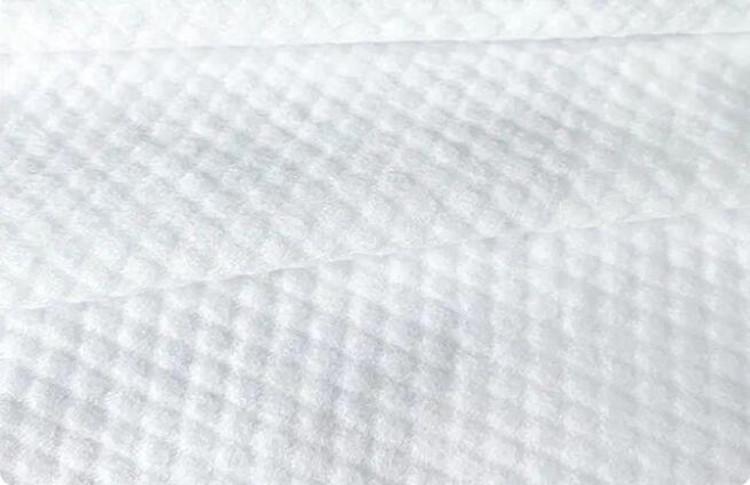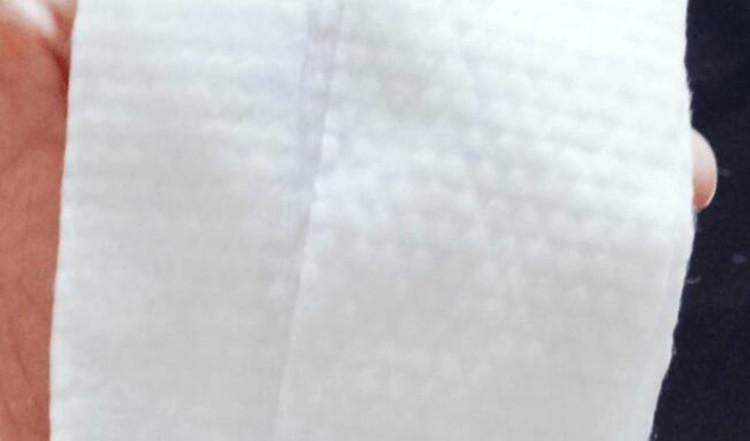Author:Baby & Adult Diaper Materials FROM:Diaper Materials Manufacturer TIME:2023-03-02
Many people think that wet wipes raw materials is the same as the material of T-shirts worn in summer, pure cotton or polyester fiber, or some other raw material, but in fact, wet wipes raw materials is not that simple. Most wet wipes are made of non woven fabrics, and non woven fabrics, also known as non woven fabrics, are a kind of fabric produced by processing various fiber raw materials with needle rolling machinery or carding machinery and formed or bonded with high pressure. shape.
Polyester is a chemical fiber derived from petrochemical industry. Compared with it, it is not so soft and has a slippery hand. It is easy to fluff after wiping. At the same time, polyester has poor hydrophilicity. During the wiping process, more water will remain on the skin. At the same time, due to the poor hydrophilicity of polyester, the moisture in the wet wipes will be due to the effect of gravity. After a period of time, the wet wipes on the upper layer tend to be dry, and the moisture content of the wet wipes on the lower layer increases, which will cause the use of a belt. some inconvenience. After all polyester wipes are used up, its chemical fibers are difficult to degrade completely in the natural environment, and oil is also a non renewable resource. Therefore, from the perspective of environmental protection and user experience, the use of polyester should be reduced. However, polyester is cheap because of its low price. Lower cost and still very popular among low priced wipes. All polyester wet wipes will emit a lot of black smoke and agglomerate after the dry base material is ignited. This simple identification method provides a qualitative basis for identifying whether the wet wipe base material contains polyester.

Viscose fiber is a fiber processed by natural plants. According to the source of raw materials, there are three common types. The viscose fiber produced from cotton pulp raw material is pure cotton non woven fabric, which is usually yellowish in color, which is relatively common. Viscose fiber produced from wood pulp raw material, the color of this fiber will be brighter, the texture of the cloth is very soft, the water retention capacity is relatively good, and relatively few are currently used in China; the viscose fiber produced from bamboo pulp is Bamboo fiber non woven fabric. The color of this kind of cloth is yellowish and the color is brighter, and it is rarely used in China. Wet wipes using viscose fiber cloth can degrade naturally and quickly in the natural environment, so it will not cause environmental pollution. The non woven fabrics of the above three types of viscose fibers can be completely burned after being ignited, and there is no residue in the ashes. This method can easily determine whether the wet tissue substrate contains polyester.

Due to cost considerations and the comfort of wet wipes, polyester fiber and viscose fiber will be used as raw materials for wet wipes in proportion, but the proportions are usually different. The lower the proportion of polyester, the higher the softness of the non woven fabric and the higher the cost of the fabric. Generally, the ratio of polyester to viscose is controlled at about 5:5. At this time, the wet wipes have moderate softness and moderate softness, and are not easy to fluff after wiping, because the water retention of viscose is better than that of all polyester wipes. Therefore, Also in the case of increasing the amount of water, the wet wipes did not feel so wet. After drying, the base cloth will emit black smoke after being ignited with a lighter. According to the proportion of polyester content, there is a certain proportion of hard lumps in the ashes.

To sum up, it is easy to judge that the wet wipes of all viscose fibers are more comfortable to use, but the price of such wet wipes is generally much higher than that of ordinary wet wipes. As a disposable sanitary product, wet wipes made of polyester and viscose are more economical and can meet the needs of use.

 Email: info@whldiapernonwoven.com
Email: info@whldiapernonwoven.com
 MP/WhatsApp: +86-13599937366
MP/WhatsApp: +86-13599937366
 Manufacturer Address:Room 1105B, Bld M1, Manhattan, Yulongwan, Shimao, Shuanglong Road, Meiling Street, Jinjiang, Fujian, China
Manufacturer Address:Room 1105B, Bld M1, Manhattan, Yulongwan, Shimao, Shuanglong Road, Meiling Street, Jinjiang, Fujian, China